No Results Found
The page you requested could not be found. Try refining your search, or use the navigation above to locate the post.





# CRM Automation, Sales Productivity, AI in Sales, Digital Transformation, Customer Experience, Future Of Work, SalesTechnology
IT service portals: the key to faster, smarter support
Support teams are under pressure to resolve requests quickly, yet many of those requests are repetitive and time-consuming. An IT service portal gives employees and customers one place to request support, find resources, and track progress. In this article, you’ll learn how IT service portals improve productivity, lower costs, and give employees more control, plus how a platform like monday service makes it easy to launch one with AI-powered automation and no-code customization.
An IT service portal is a digital workspace where employees and customers can access IT resources, request support, and track updates in one place. Instead of relying on manual replies from a helpdesk, people get self-service options that resolve issues quickly.
The goal is twofold: give employees more control over support and shift IT’s focus from routine tickets to higher-value work. Unlike a traditional helpdesk that manages requests one by one, a service portal reduces that dependency with tools like a knowledge base, service catalogue, and automated workflows.
IT teams face growing demands, while employees expect quick answers. A self-service portal supports both needs:
When employees can find answers quickly, ticket volume naturally drops and both IT and employees benefit.
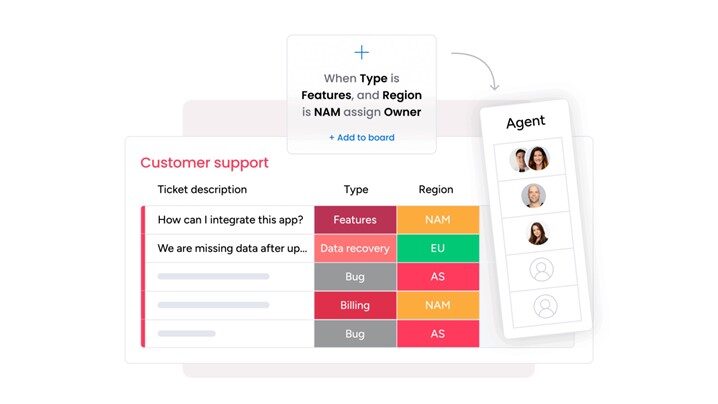
An IT service portal should deliver more than basic ticket logging. The right features drive adoption, make self-service usable, and give IT the visibility to manage requests efficiently. Together, these capabilities create a smoother experience for employees and measurable gains for IT.
A knowledge base is the foundation of self-service. Step-by-step guides, FAQs, and troubleshooting walkthroughs let employees solve routine issues on their own. This reduces wait times and shifts IT’s focus to more strategic projects. To be effective, a knowledge base should be easy to update, searchable, and accessible across devices.
A service catalogue standardizes how employees request access, devices, or software. Instead of sending ad hoc emails, they choose from predefined services with clear descriptions and approval workflows. This consistency helps IT track requests from submission through resolution without unnecessary manual effort.
Some issues still require IT support. A strong portal makes ticket logging simple and transparent, giving employees clear visibility into ownership and progress. Features like automated notifications, ticket history, and SLA tracking strengthen trust and reduce back-and-forth communication.
Search is what makes self-service usable. Employees should be able to quickly find the right resource without sifting through long lists. A modern portal surfaces the most relevant content, whether it’s a guide, a catalogue item, or an open ticket, so users can resolve issues faster.
Automation reduces the manual work that slows IT down. Routing tickets to the right team, sending closure messages, and escalating requests at risk of breaching SLAs all keep requests moving. With fewer routine tasks to manage, IT can dedicate time to innovation and long-term improvements.
Employees sometimes need immediate support. The live chat inside the portal connects them directly with IT for pressing issues, while proactive announcements, such as planned maintenance or outages, help reduce duplicate tickets. With monday service, teams can also push updates directly into Slack channels to keep employees informed without switching tools.
Selecting an IT service portal requires more than a feature checklist. The best option will support your scale, adapt to your processes, and protect sensitive data.
The right portal balances robust functionality with usability, giving IT the control they need while creating a seamless experience employees will use every day.
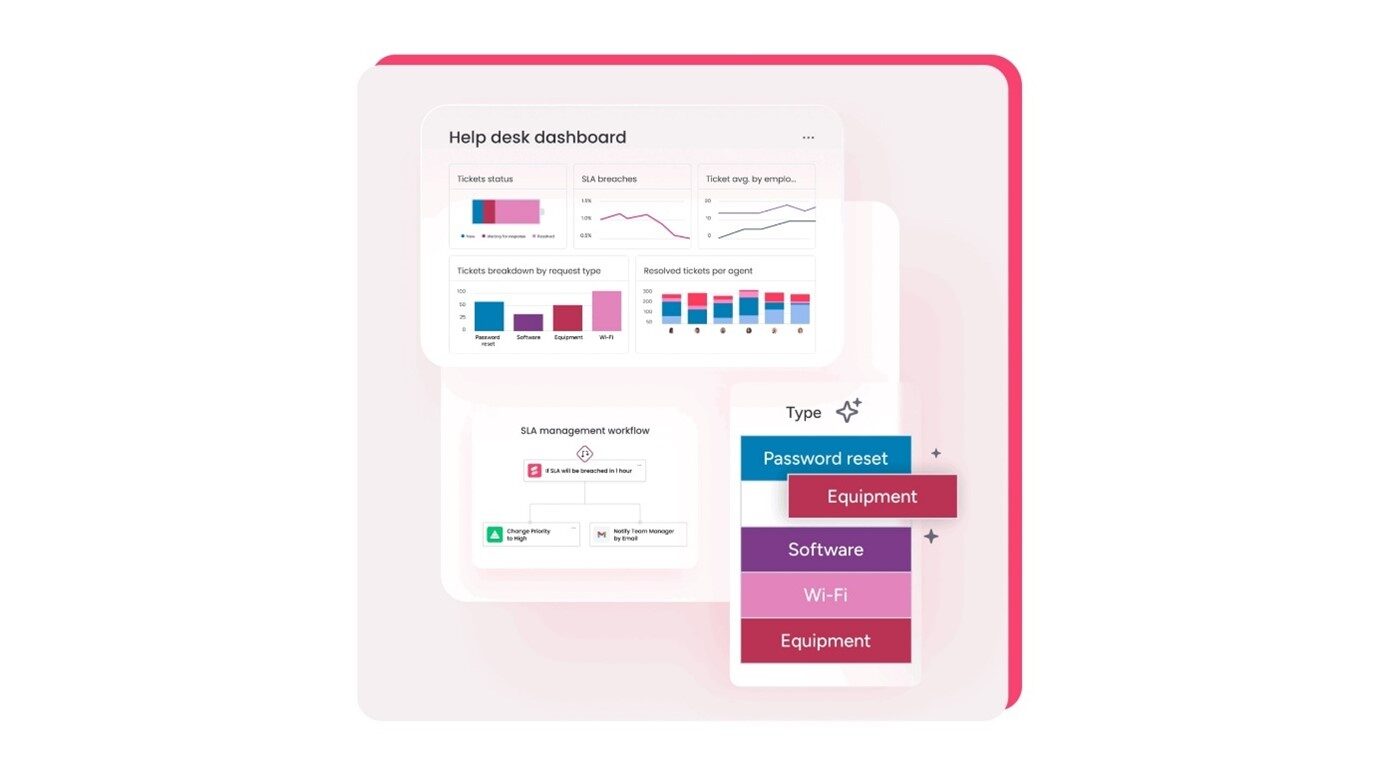
Many portals are complex to implement and difficult for employees to adopt. The monday service platform provides an intuitive, customizable platform that fits your workflows and scales with your organization.
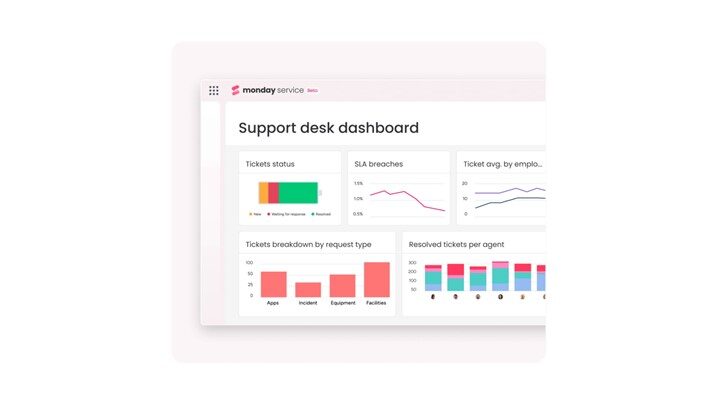
Requests, tickets, and service catalogue items live in one place. IT teams gain full visibility into every ticket and its related project milestones, ensuring issues are resolved with the broader context in mind.
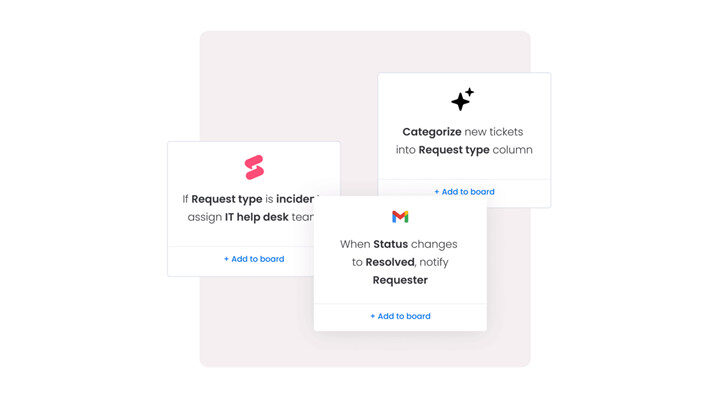
AI routes tickets to the right team, suggests next steps, and triggers CSAT surveys automatically. Automations close resolved tickets, send updates, and escalate urgent issues to keep work moving.
Unlike traditional ITSM (IT service management) tools that stop at routing, monday service AI learns from past tickets and employee behavior. It recommends next-best actions, predicts recurring issues, and surfaces relevant knowledge base content proactively — helping teams prevent problems before they escalate.
Every organization has different needs. The flexibility of monday service makes it easy to brand your portal, configure request forms, and adjust approval paths without developer support. As needs change, workflows can be updated in minutes.
Service requests often involve HR, finance, or operations management. Collaboration is seamless with monday service, which allows teams to add approvers, share updates, and attach files directly within a ticket. Everyone stays aligned with the complete history in one place.
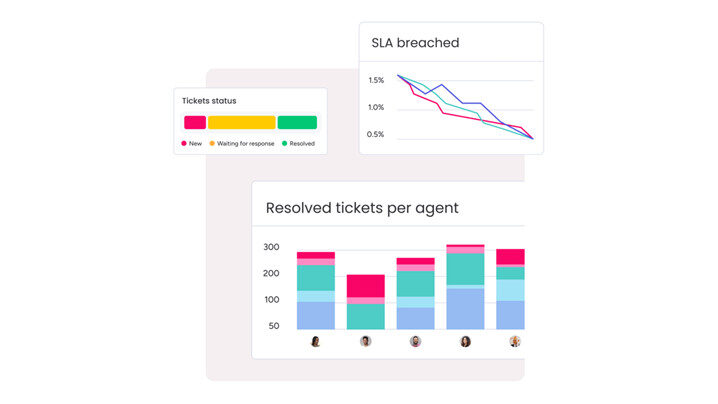
Dashboards display SLA (service level agreement) performance, ticket volumes, and recurring issues. Because service data connects with related projects, leaders can identify trends, address bottlenecks, and prevent problems before they affect the business.
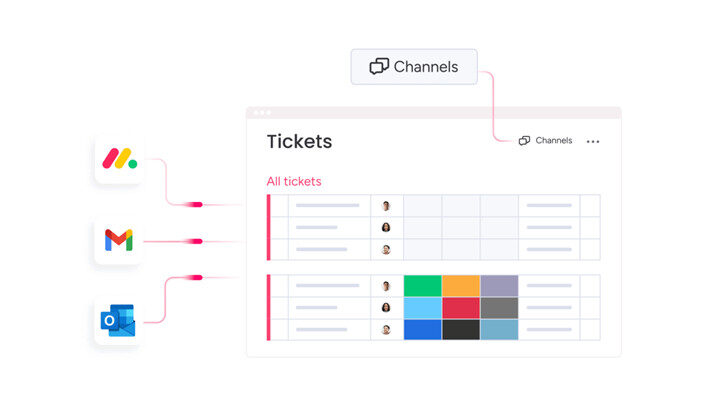
Outlook and Gmail tickets flow directly into monday service. Slack channels display live updates. Azure DevOps connects development workflows, while DocuSign brings contracts and SLAs into one system. These integrations cut context switching and improve efficiency.
Enterprise identity and governance features such as SSO/SAML, SCIM, granular roles, and audit logs are built into monday service. Data is encrypted in transit and at rest, and the platform’s architecture supports high ticket volumes and multi-department operations without sacrificing performance.
Employees can submit requests and track progress from any device. Branded domains build trust, while live chat delivers real-time support when needed. A mobile-friendly interface ensures employees get help wherever they work.
Rolling out a service portal requires clear goals, careful planning, and consistent follow-through. A structured approach ensures it delivers long-term value.
Identify the challenges your portal should address. Common objectives include cutting down on duplicate requests, improving SLA compliance, and giving employees faster access to support. Involve IT, HR, operations, and other stakeholders early to set measurable success criteria.
The value of a portal depends on the resources it offers. Create a knowledge base with troubleshooting guides, FAQs, and how-tos for common issues like password resets or access requests. Add a service catalogue with structured forms and approval paths so employees can request hardware, software, or permissions consistently.
Awareness is critical. Communicate benefits such as faster resolutions, self-service options, and request visibility across internal channels. Provide short training or quick-start guides to help employees feel confident using the portal.
Adoption challenges are common and employees may continue to email IT or hesitate to use automation. These barriers are reduced with monday service through embedded support in Slack and Outlook, plus transparent status tracking that helps employees see progress in real time.
Track performance against your goals with built-in dashboards. Monitor ticket volume, SLA compliance, and CSAT scores. Gather employee feedback to refine workflows, expand the service catalogue, and update content. The dashboards in monday service make it easy to spot trends and adjust quickly.
Successful portals evolve over time. Continuous updates and improvements keep the experience relevant and useful.
An IT service portal cuts down on duplicate requests, lowers costs, and delivers a smoother experience for employees. It also gives IT leaders the visibility they need to operate efficiently.
With monday service, you can launch a portal that’s easy to adopt, customizable to your workflows, and powered by AI. The sooner you shift to an intelligent service portal, the faster your teams can focus on strategic work and innovation.
The page you requested could not be found. Try refining your search, or use the navigation above to locate the post.

# CRM Automation, Sales Productivity, AI in Sales, Digital Transformation, Customer Experience, Future Of Work, SalesTechnology
Choosing the right product management platform is a pivotal decision for modern teams aiming to deliver exceptional products. Both Productboard and Jira offer distinct strengths tailored to different workflows and priorities.
Productboard centralizes customer feedback and aligns roadmaps, making it a favorite among product managers focused on prioritizing features. Jira, on the other hand, is renowned for its issue tracking, deep workflow customization, and scalability, making it the go-to choice for engineering and Agile development teams.
However, if your team needs a flexible, all-in-one solution that combines intuitive customization, seamless collaboration, and advanced AI capabilities, monday dev emerges as a compelling alternative.
In this guide, we’ll compare each platform’s features, integrations, pricing, support, and customer reviews so you can find the best fit for your team’s unique needs.
Try monday dev
Short on time? Here’s what you need to know about Productboard and Jira in a nutshell.
|
Criteria |
Productboard |
Jira |
|
Features |
Feedback management |
Agile boards |
|
Feature prioritization |
Workflow customization |
|
|
Customizable roadmaps |
Issue tracking |
|
|
Real-time collaboration |
Advanced reporting |
|
|
AI-powered insights via add-on |
AI-powered insights built-in |
|
|
Integrations |
18+ native integrations plus thousands more through third-party platforms like Zapier, Make, and Integrately |
3,000+ via Atlassian Marketplace, including Bitbucket, Confluence, GitHub, GitLab, and Slack |
|
Pricing |
Free plan available; premium plans from $19/maker/month |
Free plan available; premium plans from $8.60/user/month |
|
Ease of use |
Intuitive user-friendly design, but extensive feature set requires short adjustment period |
Powerful but complex with a steep learning curve especially for non-technical teams |
|
Support |
Tiered level support ranging from the online community to priority email support, depending on the pricing plan |
Tiered level support ranging from the online community to 24/7 premium support, depending on the pricing plan |
|
Ratings |
4.3/5 (250+ reviews) on G2 |
4.3/5 (6,450+ reviews) on G2 |
For a more detailed breakdown of Jira and Productboard, continue reading below.

When choosing between Productboard and Jira, understanding their core features is essential to finding the right fit for your team’s workflow. Each platform brings a different set of strengths to the table, influencing how teams plan, collaborate, and deliver projects.
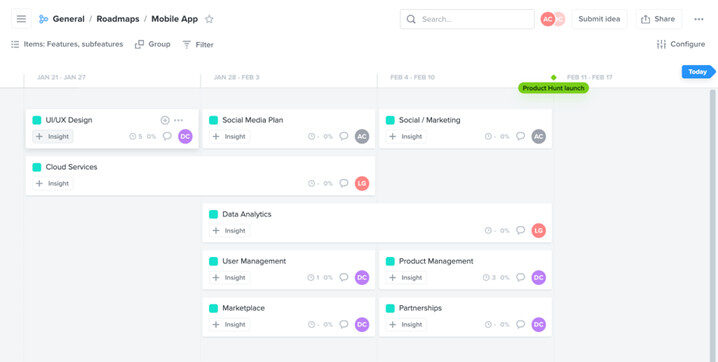
Productboard enables product teams to make informed decisions by organizing insights and aligning stakeholders around a shared vision. Its suite of tools prioritizes what to build next and ensures everyone stays focused on customer value.
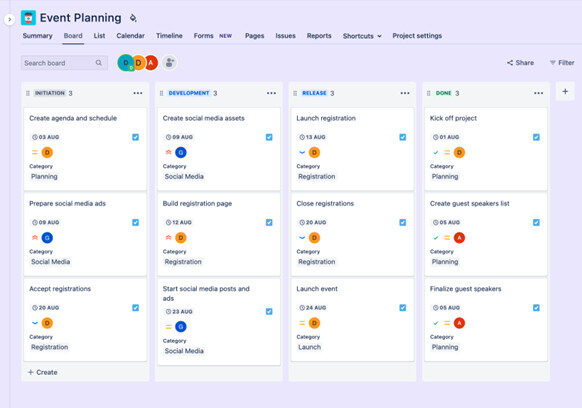
Jira allows engineering teams to manage projects at scale and adapt to evolving requirements. Its feature set supports detailed workflow management and seamless coordination across complex engineering environments.
When evaluating Productboard and Jira, integration capabilities are a key factor in supporting seamless workflows across teams and tools. Both platforms offer extensive options to connect with external systems, but their approaches and depth of integration may influence which solution best fits your organization’s needs.
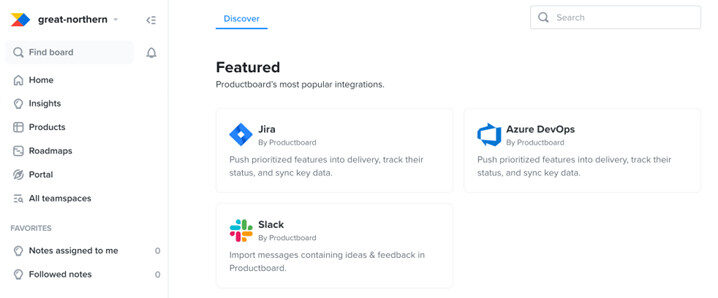
Productboard makes it easy for teams to connect with popular tools such as Jira, Azure DevOps, and Slack, supporting a unified workflow across product and development. Its open APIs and powerful two-way Jira integration enable seamless transfer of prioritized features into engineering backlogs, ensuring alignment from planning through execution.
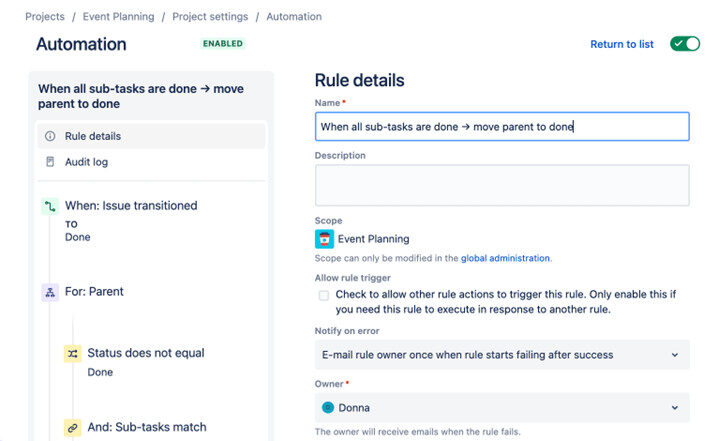
Jira offers one of the largest integration ecosystems, with thousands of available apps in its Atlassian Marketplace and native connections to tools such as Bitbucket, Opsgenie, and Confluence. Teams can automate processes and extend functionality using OpenAPI support, though advanced integrations may require additional third-party apps or administrative setup.
Pricing is a crucial factor when selecting a product management or development platform, as it impacts both your budget and the features available to your team. Both Productboard and Jira offer tiered plans to accommodate a range of business sizes, but their pricing models and included capabilities differ significantly. You can evaluate features with a free trial before committing to a paid plan.
Productboard’s pricing structure scales with your team, from a free plan for individuals to custom options for larger organizations. The platform charges per “maker” — the users who actively manage and prioritize features — while contributors and viewers are free, making it flexible for teams with varying roles. But AI features are only available via the Pulse add-on.
Jira provides a flexible, per-user pricing model with plans that cater to everyone from small teams to large enterprises. Each tier unlocks additional storage, automation, and administrative controls, allowing teams to choose the best fit for their workflow and scale as needed. Jira AI — branded as Atlassian Intelligence — is included with Premium and Enterprise packages, with plans to roll out to the Standard tier as well.
Note: Atlassian announced that in mid-2025 it will begin implementing “maximum quantity billing” for some Jira Cloud customers. This means teams may be billed based on the highest user count over a billing cycle — not just the current active users — potentially affecting how seat-based costs are calculated.
Read more about Jira’s plans and pricing.
Selecting a platform that your team can adopt quickly and use efficiently is essential for productivity and long-term success. Both Productboard and Jira offer robust capabilities, but their approaches to usability and onboarding could significantly impact your team’s experience.
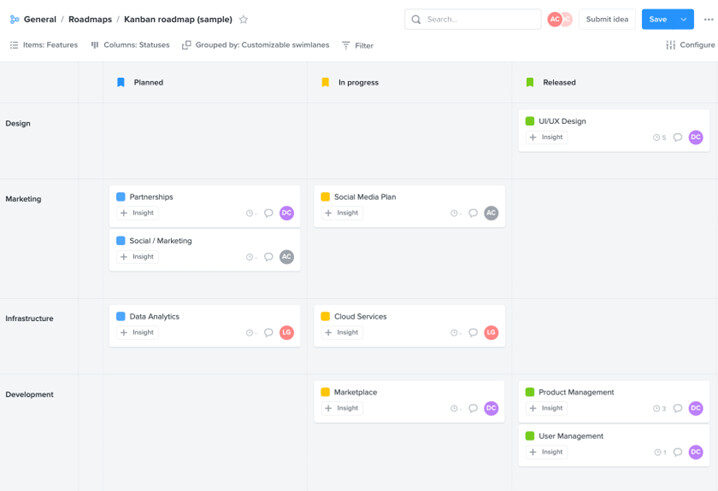
Productboard’s intuitive, user-friendly interface makes navigation and daily tasks straightforward for both technical and non-technical users. Onboarding is typically fast, though some teams may experience initial confusion due to the platform’s extensive feature set, which can require a short adjustment period.
“It’s really easy to use, and my team can implement it without extensive training. By integrating with other tools like Slack and Jira, it becomes even more integrated to our workflow.” — Denis W.
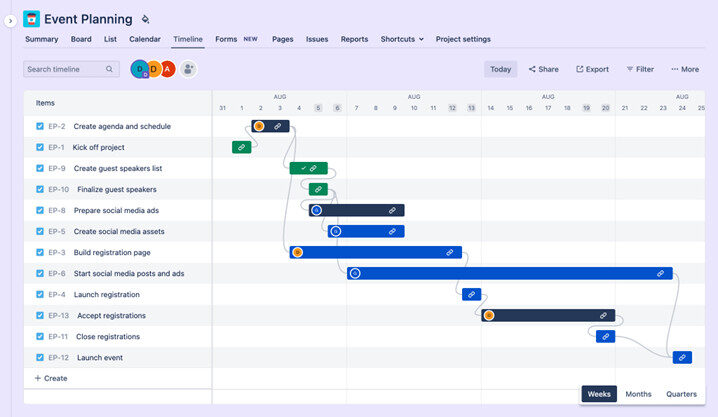
Jira provides powerful customization and workflow options, but its setup can feel overwhelming, especially for new users or teams unfamiliar with Agile tools. The platform’s steep learning curve and need for ongoing administrative support to tailor workflows and settings mean that teams often invest more time in configuration and training before reaching full productivity.
“The main issue is that it’s too complex. At first, there are so many features that it’s overwhelming. You spend a lot of time just trying to figure things out.” — Vüqar
Reliable support is vital for teams adopting new platforms, especially when troubleshooting or onboarding at scale. Productboard and Jira take different approaches to customer assistance, which can influence user satisfaction and long-term success.
Productboard offers a responsive customer support team, ensuring users receive timely help when needed. The platform also provides a comprehensive help center and onboarding resources, with tiered support available according to pricing plans:
“Productboard offers outstanding customer support. Whenever we’ve come across any issues, their team has been quick to respond with friendly and helpful assistance.” — Matthew M.
Jira includes standard support with all plans, but access to advanced assistance and faster response times typically requires an upgrade to higher-tier subscriptions. Some users have reported that support can feel slow or impersonal, particularly on basic plans, which may affect the overall experience for teams seeking hands-on guidance.
“I feel its customer support response for the complaints and issues in the app can be a bit faster.” — Spandhana E.

Understanding customer experiences with Productboard and Jira can offer valuable insight into how each platform performs in real-world scenarios. Reviews highlight the unique strengths and challenges of both tools, helping you determine which product is the best fit for your team.
Productboard receives strong praise for its ability to centralize feedback and help teams prioritize features, with many users highlighting its intuitive interface and collaborative environment. However, some reviewers note that performance can lag with larger datasets and that mastering advanced features may require a period of adjustment, particularly for new users.
“What I like most about Productboard is that it aggregates all the customer feedback in one location. This helps us more easily to determine which features to prioritize, which translates directly to our product vision. The only problem with Productboard is the fact that the software slows down when dealing with massive data sets.” — Mariusz O.
Compare:
Jira customer reviews
Users frequently commend Jira for its flexibility and the depth it brings to software development workflows, especially in environments that require robust customization and reporting. At the same time, users often point out the platform’s complexity and the ongoing need for administrative expertise, with opinions on usability ranging from highly positive to mixed depending on team experience and technical proficiency.
“What I like best about Jira is that everything goes into one place and it is easy to manage complex projects. Its capability for customizing the workflows, building out descriptive tickets, and tracking progress visually really assists with organization. What I do not like about Jira is that it is very confusing and overwhelming, especially to non-techie or novice users. There are just too many features and settings that can easily get lost or waste time figuring out how to do something instead of working.” — Pradeep S.
Compare:
Choosing between Productboard and Jira depends on your team’s primary goals, workflow preferences, and the challenges you want to solve. Both platforms are industry leaders, but they cater to different needs and excel in distinct areas.
Productboard is ideal for product managers and organizations focused on customer feedback, feature prioritization, and clear product roadmaps. Its strengths lie in centralizing insights, aligning teams, and making data-driven decisions.
Jira is best suited for software development and engineering teams that require deep workflow customization, Agile project management, and advanced reporting. It offers powerful tools for managing complex development cycles but may require more setup and ongoing administration.
|
Criteria |
Productboard |
Jira |
|
Ideal use case |
Product managers, feedback-driven organizations |
Agile engineering and dev teams |
|
Overall strengths |
Centralized feedback, feature prioritization, customizable roadmaps, team alignment |
Customizable workflows, Agile tools, vast integration ecosystem |
|
Main drawbacks |
Higher pricing at scale, some advanced features gated to higher tiers |
Steep learning curve, admin overhead, advanced features require add-ons |
To summarise:
But what if you’re looking for a platform that balances product planning, engineering execution, and user-friendly AI tools — all in one place? That’s where monday dev stands out. When you compare the G2 ratings, monday dev outperforms both Jira and Productboard in every category:
|
Criteria |
monday dev |
Productboard |
Jira |
|
Meets requirements |
9.1/10 |
8.1/10 |
8.8/10 |
|
Ease of use |
9.1/10 |
8.2/10 |
8/10 |
|
Ease of setup |
9/10 |
8.2/10 |
7.7/10 |
|
Ease of admin |
9.2/10 |
8.8/10 |
7.5/10 |
|
Quality of support |
9.1/10 |
8.9/10 |
8.3/10 |
|
Has the product been a good partner in doing business? |
9.4/10 |
8.8/10 |
8.5/10 |
|
Product direction (positive) |
9.5/10 |
8.3/10 |
8.3/10 |
|
Product management |
8.9/10 |
7.5/10 |
8.5/10 |
The right choice ultimately depends on your team’s priorities, technical needs, and long-term goals. But for teams seeking a balance of flexibility, ease of use, and advanced AI capabilities, consider exploring a flexible alternative like monday dev.
Try monday dev with The CRM Team
Built on the robust monday.com Work OS, monday dev is a frictionless, AI-powered platform that unites product and engineering teams. With effortless customization, hybrid project support, and advanced reporting all in one platform, monday dev adapts to your team’s needs.
No-code customization: Tailor Kanban or Scrum boards with custom columns, statuses, and automations, using simple drag-and-drop — no coding or admin help needed.
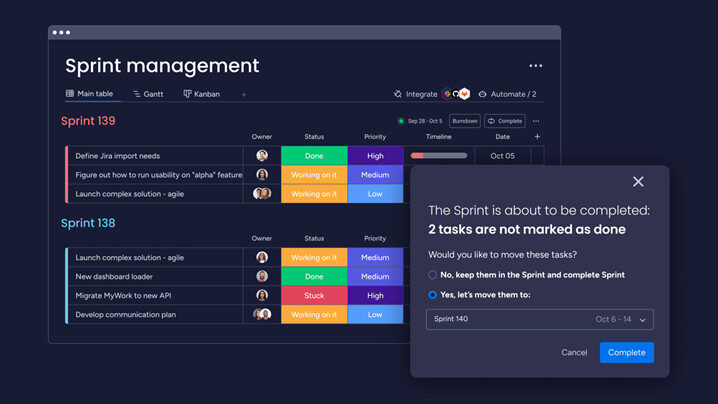
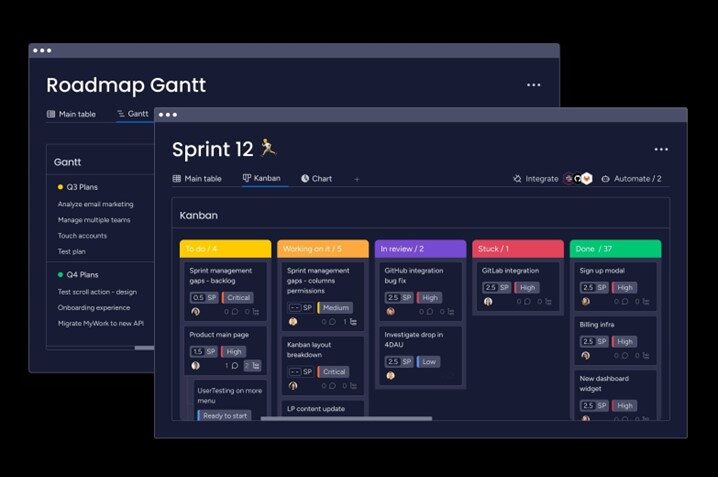
Built-in management-level reporting: Visualize different information across the organization, including Agile insights, performance dashboards, roadmap planning, and team hierarchies — no plugins needed.
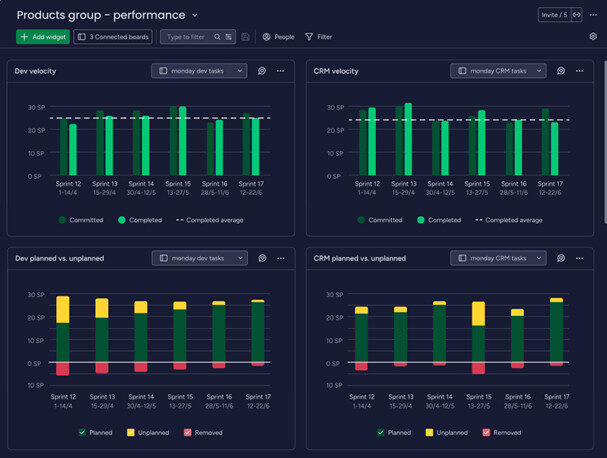
Seamless collaboration: Keep everyone aligned and informed on a single platform with workdocs, dependency tracking, and real-time updates — without switching tools.
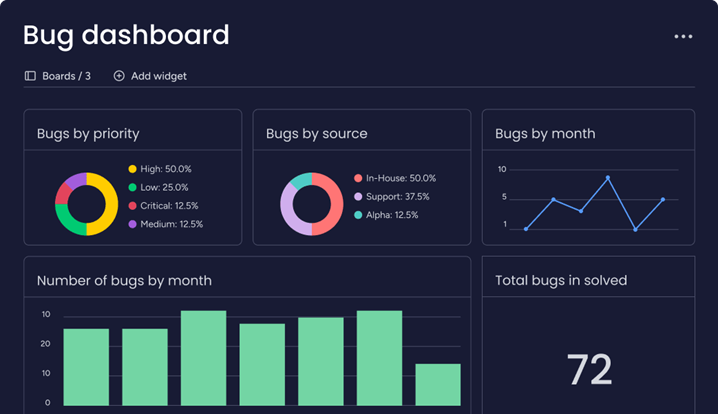
AI-powered productivity: Use ready-made AI actions to forecast velocity, identify bottlenecks, and automate routine tasks — right where you work.
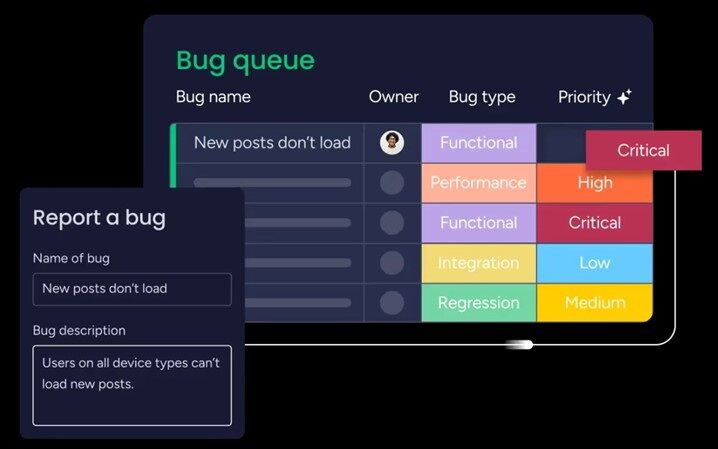
Unlike Productboard and Jira, which often require admin setup or additional apps for advanced connections, monday dev connects effortlessly with over 200 tools, including GitHub, GitLab, CircleCI, Slack, and Microsoft Teams, through a user-friendly, no-code integration hub.
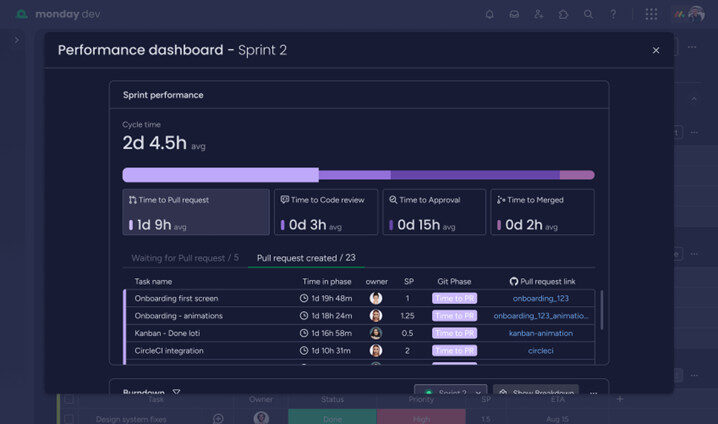
“A lot of the tools we tried were just too rigid to meet our needs. We had to connect multiple products to get the results we wanted, which created even more friction between our teams. With monday dev, everyone at luxie tech has access to the information they need to do great work.” — Mitchell Hudson.
Compared to Jira’s multiple add-ons, monday dev’s transparent and scalable pricing makes it exceptionally cost-effective for large teams seeking predictable, all-in-one value.
Read more about monday dev’s plans and pricing.
With monday dev, teams can instantly customize workflows using drag-and-drop boards, custom columns, and automations—no coding or IT support required. Its intuitive interface and ready-to-use templates make it easy for anyone to set up and adapt processes, so both technical and non-technical users enjoy a seamless onboarding experience and can start collaborating right away.
“The other systems we explored were rigid and lacked the ability to nest and marry items together. They were also so complex that it would also require a full-time administrator to run. We loved that anyone on the team could easily get up to speed with monday dev.” — Steven Hamrell.
With monday dev, every customer receives fast, friendly 24/7 support from real people on every plan. In addition to responsive phone, email, and live chat, customers benefit from a comprehensive resource library — including a community forum, self-serve knowledge base, video tutorials, daily live webinars, and dedicated customer success managers for enterprise accounts — making support highly rated for both responsiveness and helpfulness.
Trusted by over 245,000 customers, monday dev earns consistently high marks from users for its intuitive interface, flexibility, and responsive support. Teams praise the platform for letting them tailor workflows to their unique needs, empowering them to work their way rather than forcing them into rigid processes.
“The user-friendly interface of monday dev makes project monitoring and planning very simple. Our team may customize the boards and workflows of the platform to meet our unique requirements. Collaboration is facilitated by integration with GitHub and Slack, and the automation capabilities let us save a ton of time on tedious work. Furthermore, the analytics and reporting tools enable us to continuously improve our procedures and offer insightful information about the status of our project.” — Siddarth N.
Ready to experience a better way to manage product development? The CRM Team and see how your team can move faster, collaborate better, and deliver more value on one flexible platform.
The page you requested could not be found. Try refining your search, or use the navigation above to locate the post.